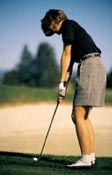How Plum-Bobbing Works
Remember, plum-bobbing is only one element in reading a putt. But interpreted correctly, it will point to the high side of the hole. It answers the question of which side of the hole has the break. That's enough; now you have to decide how fast it will be.
So how does it work? The weight of the putter blade will settle over the low side of the hole when you face the hole. The grip will point to the high side of the hole, and show you how much it breaks.
Roll Your Rock
To plum-bob, stand behind the ball far enough to see the ball at the neck of the putter and try to place the hole around the top of the shaft.
At the same time, look down the line the putt will roll on toward the hole. And hold the putter by the shaft between your thumb and index finger, lightly. The skill is in getting the speed correct.
A putt is a combination of line (the direction), speed (fast or slow), and distance (how far; 10 feet, etc.) Now, do you see where plum-bobbing comes into the picture of putting?
Let's hold speed and distance for later. Now focus on how you find the line of a putt.
So when you are reading a putt and you want to be sure of the direction the putt will break, just plum-bob it. Remember, the grip on the handle will show you which side and how much break there will be - when interpreted correctly. You must learn to trust your information. But try it first, then trust it!
Related Topics
Perfectly Simple Golfing Tips
Search For Golf Tips
Plum-Bobbing The Golf Putt


























